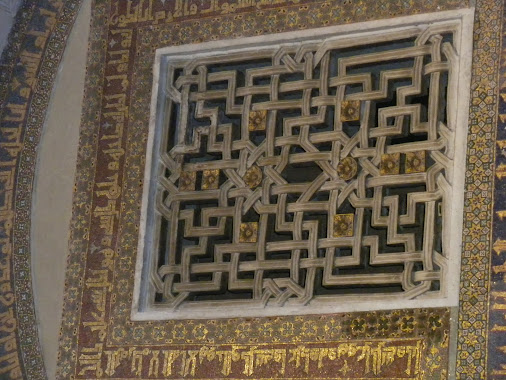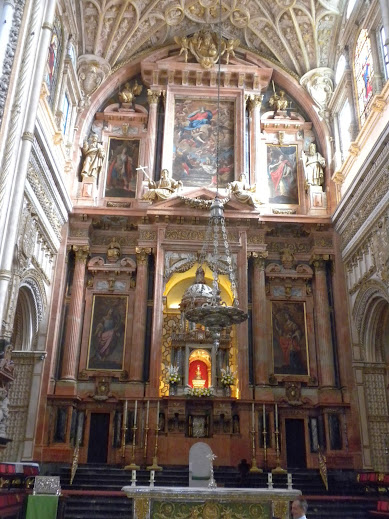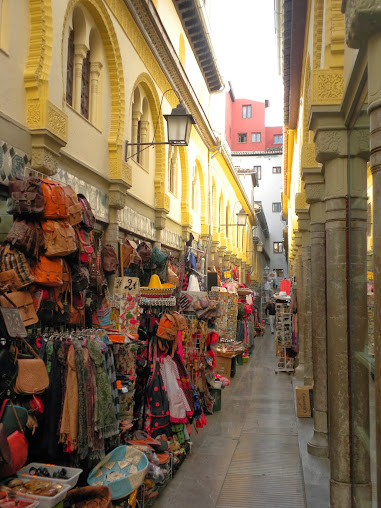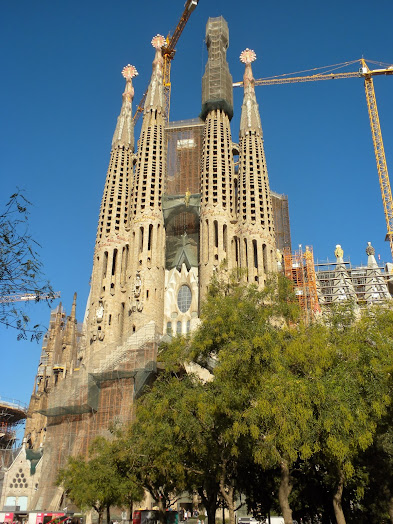Carol
writes: For several days Al and I
debated whether it would be worth the hassle to attempt to visit Gibraltar, a
British possession which therefore would require an international border
crossing. We had read that the border between
Spain and Gibraltar could have unwanted traffic congestion, something we try to
avoid, if possible, since we are 23 feet long.
Nonetheless, we had another gorgeous sunny day and so we decided to
drive as close as we could to the Rock of Gibraltar so we could at least take a
look. In Cordoba, a fellow camper had told
us about a large parking area near the border crossing, and he also said that
camping overnight was allowed there. Was
this too good to be true?
Sometimes
the stars align perfectly and the solution to a question falls right into your
lap, and that is what happened to us. We
easily found the large parking area within walking distance of the border. The parking lot was part of a marina area and
was huge, clean, safe, relatively deserted, and had a knockout view of the
Rock!
We were told
it was permissible to spend the night there in our RV. The border was only a 10-minute stroll, and
so we set off. Passing through customs
control was a breeze. We even had to ask
British customs to stamp our passports, and they courteously obliged us. We like to have a stamp every now and then to
document our travels dates to prove our compliance with Schengen rules. More about that later…
The walk
into Gibraltar was a strange one at the start.
Both the auto route and the pedestrian walking path bisected the airport
runway into Gibraltar’s air terminal!
I’m not quite sure what the procedure would be to clear the runway of
people and cars if a plane was approaching for a landing.
One of
Gibraltar’s more interesting sights, besides its impressive ‘Rock’, is the fact
that the area is home to a Barbary monkey population. The monkeys have free reign of ‘The Rock’ and
the town and serve to either delight or pester the tourists, depending on
whether they are posing for an adorable camera shot or, alternatively, biting
you and/or stealing the bag you are carrying in hopes it contains some goodies
to eat. It wasn’t long before we encountered
a “monkey jam.”
But…more
monkey shots later.
By the time
we arrived at the foot of the cable cars that serve as transportation to the
Top of the Rock (the REAL ROCK, not NBC’s home on Rockefeller Square), we knew
we had to spring for the pricey ride to the top. Took all of 6 minutes to get to the top. We were astounded at the 360-degree views,
looking down
on Gibraltar and the harbor area,
back at the
tip of the Rock itself,
and across
the Strait of Gibraltar for a view into Morocco’s mountains on the dark African
continent.
Of course,
the monkeys at the top provided great photo opportunities, especially this
incredibly photogenic mother and baby.
Everyone
gets their own monkey shot…
We wanted to
linger as long as possible at the top because we just couldn’t get enough of
the views. We lingered over coffee/beer
at the café up top, gazing through the floor-length windows into the calm blue
waters of the Mediterranean Sea and watching the monkeys play. We both agreed that the Top of the Rock at
Gibraltar ranked near the very top of our European RV adventure, and to think
that we almost didn’t make the Gibraltar side trip…
Our evening
back in the RV at our premier camping spot at the marina was quite spectacular
at sunset.
Then, at
daybreak the next morning, we looked out the window and saw a dazzling full
moon about to set. Doesn’t get any
better than that!
NAVAL AIR
STATION IN ROTA, SPAIN: The next step in our game plan was to head to
the Naval Air Station at Rota, Spain, about a 2-hour drive from Gibraltar. We were anxious to take advantage of the spacious
room (with a small kitchen) that we had booked for a few days of rest,
relaxation, catching up on household chores, and planning for the next two
months. A real bed and a Broncos game on
Armed Forces Network TV tend to go a long way toward refreshing our minds and
bodies.
Our dilemma
on how to proceed with the next few months of travels in Europe boils down to a
calendar issue. Winter is approaching,
even in sunny Spain. In addition, in
order to remain compliant with Schengen rules, we are allowed to stay in the
Schengen countries, which include most of the 26 countries in Western Europe,
only 90 days out of every 180 days. We
spent our first 90 days in Western Europe in the Schengen countries during the
first three months of our European adventure (mid-April to mid-July). Then, we left the Schengen area for 90 days
in the United Kingdom and the Republic of Ireland (mid-July to mid-October). We have been back in Schengen for the past 5
weeks (since mid-October) and are faced with leaving for another 90 days by
January 11th. Where to go? Morocco and Turkey are our only viable
options, and Turkey is a long, long drive from Spain. Neither country would seem to have enough to
keep us occupied for 90 days, not to mention safety issues. This is the dilemma we have been facing for
the past 8 months, but we have now reached decision time because winter is fast
approaching and we must leave the Schengen area in 7 weeks.
So…we have
decided for many, many reasons that it is time to think about shipping the RV
home and catching a Space-Available flight back to the States with the US Air
Force in Ramstein, Germany. With use of
all the handy technology on the naval base here in Rota (i.e., Internet,
faxing, and library facilities), we have booked a December 13th
sailing date for our RV out of…Amsterdam…same place where we picked it up last
April. We are satisfied with our game
plan. We have admitted to each other
that we are getting tired after the nonstop pace we have been keeping since we
left Colorado in March. We have
experienced the thrill of many lifetimes with our travel adventures, and it is
time to start closing out this European chapter.
By the time
we get back to our home in Colorado, we will have been gone for almost a
year. Many practical and mundane issues
that have no easy solutions cannot be ignored beyond a year--healthcare, dental
care, prescriptions, taxes, mail, vehicle license renewals, RV servicing issues. You get the idea…
After a few
more days of rest here in Rota, we will head over to check out the Algarve in
southern Portugal and then head north by a long route to Amsterdam to drop off
the RV for shipping. In the meantime, we
have a lot to see, countless unknown adventures ahead, and many miles to travel
back to Colorado. Stay tuned for more
blog posts…
“Neither the incursions of Moor, the
Spaniards nor the English, nor cannon nor bomb of either have been able to
dislodge them.” Ignacio López de Ayala,
writing about the monkeys of Gibraltar in his “History of Gibraltar” (1782)


















































.jpg)
.jpg)
.jpg)
.jpg)
.jpg)


.jpg)


.jpg)
